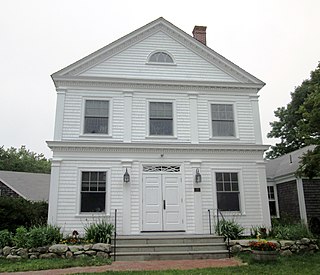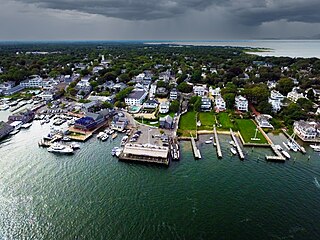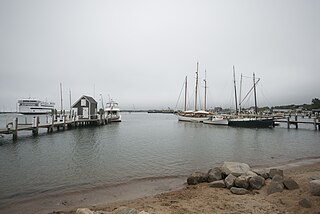Related Research Articles

Martha's Vineyard, often simply called the Vineyard, is an island in the U.S. state of Massachusetts, lying just south of Cape Cod. It is known for being a popular, affluent summer colony, and includes the smaller peninsula Chappaquiddick Island. It is the 58th largest island in the U.S., with a land area of about 96 square miles (250 km2), and the third-largest on the East Coast, after Long Island and Mount Desert Island. Martha's Vineyard constitutes the bulk of Dukes County, Massachusetts, which also includes the Elizabeth Islands and the island of Nomans Land.

Nantucket is an island in the state of Massachusetts in the United States, about 30 miles (48 km) south of the Cape Cod peninsula. Together with the small islands of Tuckernuck and Muskeget, it constitutes the Town and County of Nantucket, a combined county/town government. Nantucket is the southeasternmost town in both Massachusetts and the New England region. The name "Nantucket" is adapted from similar Algonquian names for the island.

Dukes County is a county in the U.S. state of Massachusetts. At the 2020 census, the population was 20,600, making it the second-least populous county in Massachusetts. Its county seat is Edgartown.

Chilmark is a town located on Martha's Vineyard in Dukes County, Massachusetts, United States. The population was 1,212 at the 2020 census. The fishing village of Menemsha is located on the western side of the town along its border with the town of Aquinnah. Chilmark had the highest median home sale price of any town or city in Massachusetts in 2013.

Edgartown is a town on the island of Martha's Vineyard in Dukes County, Massachusetts, United States, for which it is the county seat. The town's population was 5,168 at the 2020 census.

Oak Bluffs is a town located on the island of Martha's Vineyard in Dukes County, Massachusetts, United States. The population was 5,341 at the 2020 United States Census. It is one of the island's principal points of arrival for summer tourists, and is noted for its "gingerbread cottages" and other well-preserved mid- to late-nineteenth-century buildings. The town has been a historically important center of African American culture since the eighteenth century.

Tisbury is a town located on Martha's Vineyard in Dukes County, Massachusetts, United States. The population was 4,815 at the 2020 census.

West Tisbury is a town located on Martha's Vineyard in Dukes County, Massachusetts, United States. The population was 3,555 at the 2020 census. Along with Chilmark and Aquinnah, West Tisbury forms "Up-Island" Martha's Vineyard.
Governor Thomas Mayhew, the Elder established the first European settlement on Martha's Vineyard, Nantucket and adjacent islands in 1642. He is one of the editors of the Bay Psalm Book, the first book published in the Thirteen Colonies. His assistant Peter Foulger was the grandfather of Benjamin Franklin.

Martha's Vineyard Regional High School or MVRHS is the primary public high school for the island of Martha's Vineyard, Massachusetts, United States. It is located in Oak Bluffs.

Monohansett was a sidewheel steamer operating as a ferry serving the island of Martha's Vineyard during the late nineteenth century. She was named after Monohansett Island, a tiny 12-acre (4.9-hectare) island off Naushon Island.

Niantic was a whaleship that brought fortune-seekers to Yerba Buena during the California Gold Rush of 1849. Run aground and converted into a storeship and hotel, she was a prominent landmark in the booming city for several years. The site of Niantic beside the Transamerica Pyramid is now a California Historical Landmark. Artifacts excavated in 1978 and the ship's log from her last voyage are on display in the San Francisco Maritime Museum.

Some members of the colonial Coffin family were whalers, agents, merchants, and traders who were prominent during the triangular trade in the United States and Canada. Coffin ship owners, captains, masters, and crew men operated triangle and bilateral trade ships out of Nantucket, Massachusetts, US eastern seaports, and Canadian seaports from the 17th to 19th centuries.
The A. T. Gifford was the last American schooner-rigged whaleship to cruise Hudson Bay. She caught fire and sank in late 1915. Although the captain and a few of his crew escaped the wreck, none survived the disaster.

The Old Mill is an historic mill building at 690 Edgartown-West Tisbury Road in West Tisbury, Massachusetts, on the island of Martha's Vineyard. The current structure was built c. 1848, and occupies a site that has seen industrial use since the 17th century. The property is currently owned by the Martha's Vineyard Garden Club.

Nantucket shipbuilding began in the late 1700s and culminated in the construction of notable whaling ships during the early 19th century. Shipbuilding was predominantly sited at Brant Point. Whaling ship construction concluded in 1838.
The whaler Globe, of Nantucket, Massachusetts, was launched in 1815. She made three whaling voyages and then in 1824, on her fourth, her crew mutinied, killing their officers. Eventually most of the mutineers were killed or captured and the vessel herself was back in Nantucket in her owners' hands. She continued to whale until about 1828. She was broken up circa 1830.

Epenow was a Nauset man from Martha's Vineyard, Massachusetts who was kidnapped by sailors from an English merchant ship and taken to England in the 17th century. Being put on public display in London, Epenow eventually returned to New England by tricking his captors into thinking that he knew the location of a gold mine. Once he was back in New England, Epenow led Indian resistance to Pilgrim settlement of the region.
The concept of the position of Martha's Vineyard Poet Laureate was formally initiated in 2011 by the Martha's Vineyard Poetry Society. This was the first time in Martha's Vineyard history that a position was created to designate an island-wide poet laureate. On similar note, the Martha's Vineyard Poetry Society (MVPS) is the first island-wide poetry organization with membership in the history of Martha's Vineyard. MVPS was founded in 2008 by island poet/author/musician, William Waterway.

Helen Jernegan was an American woman and wife of a whaler. She began her career as a teacher in 1859 and then married a whaling captain. As he missed his wife, he sent for her to join him and she met him in Honolulu, Kingdom of Hawai'i. The two sailed back to New Bedford aboard the Oriole arriving in 1866. Two years later, she went aboard ship with her husband and children, and lived in Honolulu and aboard his ship the Roman until 1871. She sailed twice around Cape Horn and was possibly the first white woman on Tahuata in the Marquesas Islands. After a mutiny on their second voyage, she returned to live on Martha's Vineyard. One of the accounts was written by her young daughter, Laura Jernegan Spear.
References
- ↑ Swan, Judy Haddock. "The Descendants of Moses Cleveland on Martha's Vineyard" . Retrieved 2012-12-07.
- ↑ Bank, Charles Edward. The History of Martha's Vineyard.[ clarification needed ]